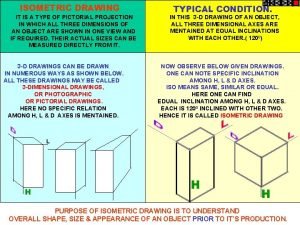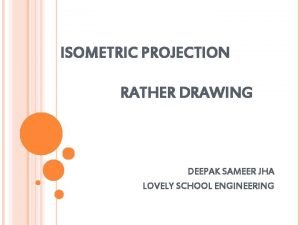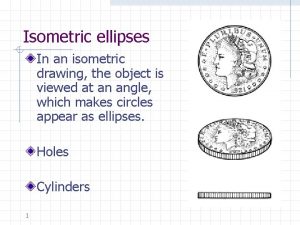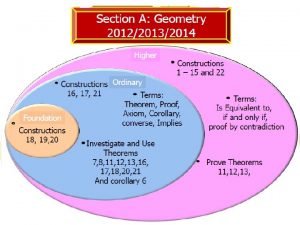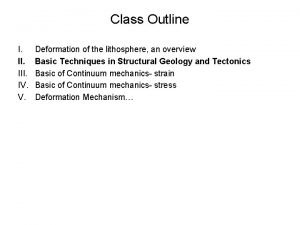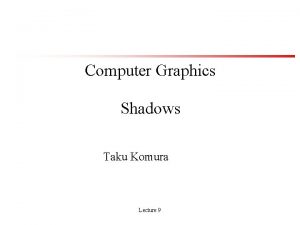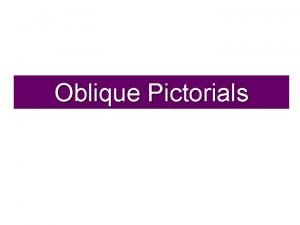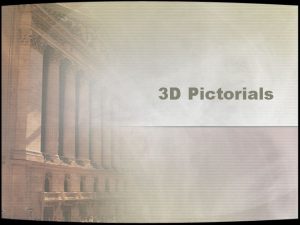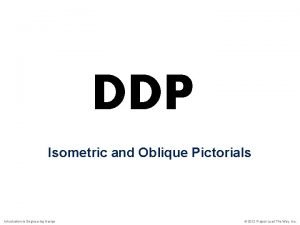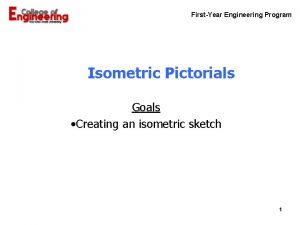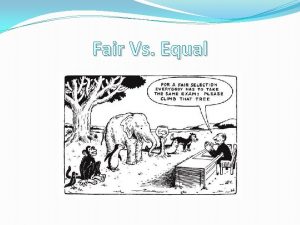Isometric Pictorials Isometric Pictorials Isometric means equal measure















- Slides: 15

Isometric Pictorials

Isometric Pictorials Isometric means equal measure. Three adjacent faces on a cube will share a single point. The edges that converge at this point will appear as 120 degree angles or 30 degrees from the horizon line. These three edges represent height, width, and depth. 12 11 10 9 1 2 1200 3 1200 4 8 7 6 5

Proportion and Estimation Good sketching requires a sense of proportion, and the ability to estimate size, distance, angles, and other spatial relationships.

The Box Method The box method is a technique used in sketching to maintain proportionality. It starts with a sketcher envisioning an object contained within an imaginary box.

Isometric Sketching Step #1: Layout the box within which the isometric view will occur using points and construction lines.

Step #1: Constructing The Box by connecting thelight dotsconstruction • • Finish Connect the dots with • withlines. Locate corners of the Be maximum light Be construction lines. sure to extend your lines past height andyour width ofpast thethe box. sure tocorners extend lines the corners • Locate the back corner of the top surface To find the angle of the depth and width – count over two … up one…

Step #2: Outside Faces • Using construction lines connect the dots • Identify where the corners of the surface would touch the box.

Step #3: Rest of Object

Steps in Drawing Step #1: Draw the Box appropriate to the type of drawing. Step #2: Draw the surfaces that touch the Box. Step #3: Draw the rest of the object. Step #4: Tonal Shading, or Hidden and Center lines.

Step #1: Constructing The Box Determine the overall dimensions of the object: • 6 units wide • 4 units tall • 4 units deep Use points and construction lines to layout the box.

Step #2: Outside Faces Use points and construction lines to identify the corners and edges of the object faces that occur on the surface of the box.

Step #2: Outside Faces cont. Before the sketch becomes too noisy with construction lines, trace out the visible edges identified thus far with object lines.

Step #3: Inside Faces Use points and construction lines to identify the corners and edges of the object faces that occur inside the box.

Step #3: Inside Faces cont. Trace out the remaining visible edges with object lines.

Step #4: Tonal Shading Decide where the light source is coming from, and add tonal shading to two of the three views with parallel lines drawn closely together. Increase the contrast by cross-hatching the lines on the darkest face.
 It means equal measure
It means equal measure A pictorial drawing that is drawn in equal measurement
A pictorial drawing that is drawn in equal measurement Isometric
Isometric Isometric pictorials
Isometric pictorials Example of pictorial drawing
Example of pictorial drawing Sketching ellipses
Sketching ellipses It means equal measure in technical drawing
It means equal measure in technical drawing Difference between equal sharing and equal grouping
Difference between equal sharing and equal grouping Are opposite angles equal
Are opposite angles equal Equal height equal light
Equal height equal light Meridionalnet
Meridionalnet Equal height equal light
Equal height equal light Hail
Hail Is measure for measure a comedy
Is measure for measure a comedy Oblique pictorials
Oblique pictorials Oblique pictorial
Oblique pictorial

